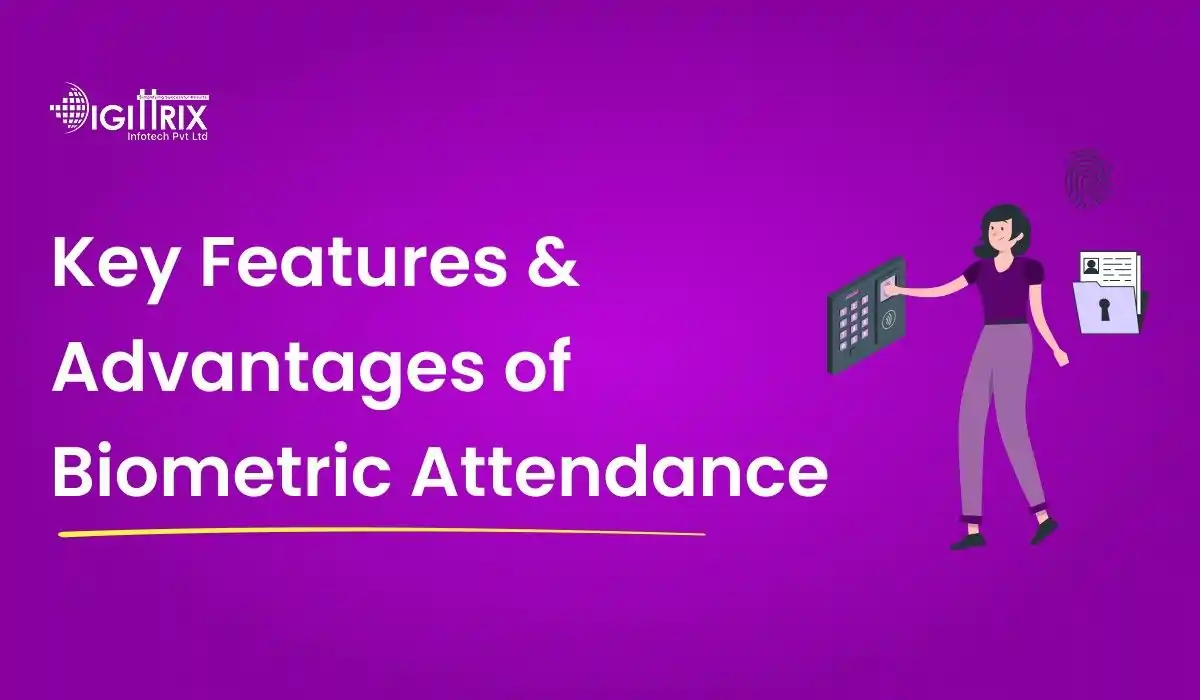A biometric attendance system enhances security, accuracy, and efficiency by using fingerprints, facial recognition, or iris scans to track employee attendance. It eliminates buddy punching, reduces errors, and improves workforce management.
Highlights
- Businesses lose up to 5% of annual revenue due to buddy punching and manual errors (Source: American Payroll Association).
- Biometric systems have an accuracy rate of over 99%, reducing attendance fraud (Source: ResearchGate).
- Automating attendance tracking can save HR teams 30-50% of their time (Source: Deloitte).
- Biometric authentication is 200% more secure than traditional ID cards or PINs (Source: IBM Security).
Co-Founder
Harsh Abrol 
5 min read
With Over 14 years of Experience in the IT Field, Helping Companies Optimise there Products for more Conversions

The biometric attendance system provides widespread usage at educational institutions combined with workplaces and various industries for precise attendance tracking of employees and students. Biometric technology including fingerprint recognition as well as facial recognition and iris scanning ensures identification verification in such systems. The system stops multiple potential mistakes that emerge from employing traditional methods consisting of manual registers or card-based entries.
How Biometric Attendance System Works
Workplace tracking systems base attendance operations on the distinct physical traits of each person they monitor. Entry into the system creates a database entry for each person which contains their stored biometric fingerprints or facial patterns and other information. The system checks their identity by matching their current data points against the previously recorded information when users perform check in or check-out operations. The system keeps track of which people hold permission to get marked as present.
Key Features of a Biometric Attendance System
- Biometric Identification: The system uses biometric identifiers such as fingerprints, facial features, or iris patterns. This stops friend punching and ensures accurate tracking of work hours.
- Integration with Payroll Software: Many systems can be linked with payroll software to automate salary calculations based on attendance data. This reduces manual work and avoids payroll differences.
- Cloud-Based Data Storage: Some biometric attendance systems offer cloud storage, allowing HR teams to access attendance records from any location. This feature is beneficial for businesses with multiple branches and can be improved by custom software solutions that provide real-time access.
- Real-Time Monitoring: Institutions can monitor attendance data in real time. If an employee or student fails to check in, an alert can be generated for quick action.
- Access Control Integration: Besides attendance tracking, biometric technology can be used to control access to restricted areas. Only authorized personnel can enter specific locations within a workplace.
- Multiple Authentication Methods: Some systems provide a combination of authentication methods, such as fingerprint recognition, PIN entry, or RFID cards, giving users multiple options to verify their identity.
- User-Friendly Interface: Most biometric attendance systems come with an easy-to-use interface, making it simple for employees and administrators to manage records without technical expertise.
- Automatic Reports and Analytics: Reports can be generated automatically, providing insights into work hours, absenteeism, and late arrivals. These reports help management make data-driven decisions with the help of custom software development services.
Benefits of Biometric Attendance System
- Eliminates Time Theft: With a biometric system, individuals cannot clock in for others. This prevents fraudulent activities like buddy punching and ensures fair attendance tracking.
- Accuracy in Attendance Records: Unlike manual systems that are prone to human errors, biometric systems record attendance with high precision. This helps in maintaining correct work hours for payroll processing.
- Increases Productivity: Since the system automatically records attendance, HR teams do not need to spend extra time on manual entries. This allows them to focus on more critical tasks.
- Improves Security: Biometric attendance systems not only track work hours but also improve security. Since fingerprints and facial features are unique, unauthorized access is significantly reduced.
- Saves Costs: Companies can save money by reducing administrative tasks, minimizing payroll errors, and preventing fraudulent timekeeping practices. Over time, this leads to better financial management.
- Supports Remote and Hybrid Work Models: For businesses with remote employees, some biometric attendance systems offer mobile applications that allow workers to log their hours from different locations using facial recognition or GPS tracking, which can be enhanced through custom software development.
- Compliance with Labor Laws: Using an electronic attendance system helps businesses maintain accurate records required for compliance with labor laws and regulations. Proper documentation ensures adherence to work-hour policies.
Different Types of Biometric Attendance Systems
- Fingerprint Attendance System: One of the most common types, this system scans and matches fingerprints to grant access. The stored data ensures that only registered users can check in or out.
- Facial Recognition System: A camera captures facial features and matches them with pre-recorded data. This method is contactless and works well in environments where hygiene is a priority.
- Iris Recognition System: By scanning the unique patterns of a person’s iris, this system provides one of the most secure biometric authentication methods. It is highly accurate and used in high-security environments.
- Voice Recognition System: This system verifies individuals based on their voice patterns. While less common than fingerprints or facial recognition, it is useful in hands-free authentication scenarios.
- Palm Vein Recognition: A sophisticated biometric method that scans the veins in a person’s palm. It is highly secure and difficult to forge, making it suitable for sensitive workplaces.
Choosing the Right Biometric Attendance System
When selecting a biometric attendance system, businesses should consider factors like accuracy, ease of integration with existing software, and scalability. Here are some important aspects to evaluate:
- Accuracy and Speed: The system should recognize users quickly and accurately to avoid delays.
- Scalability: It should be able to accommodate an increasing number of users as the business grows.
- Data Security: The biometric data must be encrypted to protect against unauthorized access.
- Integration with HR and Payroll Systems: Compatibility with existing HR tools simplifies attendance management.
- Cost-Effectiveness: The system should provide long-term value while staying within budget.
Common Applications of Biometric Attendance Systems
Corporate Offices: Companies use biometric attendance to track employee work hours and reduce unauthorized absenteeism.
Educational Institutions: Schools and universities implement these systems to monitor student and staff attendance accurately.
Manufacturing Industries: Factories use fingerprint or facial recognition attendance systems to manage shift workers efficiently.
Healthcare Sector: Hospitals and clinics use biometric attendance to track medical staff shifts and ensure timely patient care.
Government Offices: Many government institutions rely on biometric systems to maintain workforce attendance records for transparency.
Challenges and Considerations
While biometric attendance systems offer several advantages, there are some challenges to consider:
- Privacy Concerns: Storing biometric data raises privacy issues. Companies must follow strict data protection regulations to ensure security.
- Environmental Factors: In some conditions, like construction sites, fingerprint readers may not work well due to dirt or moisture. Alternative methods like facial recognition may be more suitable.
- Initial Setup Costs: Although long-term savings are significant, the initial investment can be high. Businesses should plan their budget accordingly.
- Technical Issues: Regular maintenance is required to ensure the system operates smoothly and efficiently.
Final Words
A biometric attendance system functions as a necessary organizational asset to improve the accuracy of attendance monitoring operations. Business operations can prevent time theft and ease payroll processing by implementing biometric technology frameworks that recognize fingerprints or faces. Its efficiency stems from three key features including integration with payroll software combined with cloud-based storage and real-time performance tracking which benefits organizations of different scales. The advantages of biometric attendance systems render their setup expenditures and privacy-related issues insignificant while becoming selected across multiple industries. A well-planned electronic attendance system both maintains precise records and enhances workforce security together with operational effectiveness in both organizations and work environments.
Develop a Biometric Attendance System with Digittrix
Traditional attendance methods often lead to errors, proxy attendance, and inefficiencies. A biometric attendance system offers a secure and automated way to track attendance using fingerprint or thumbprint authentication. This ensures accuracy while preventing unauthorized access.
At Digittrix, we develop custom software solutions for businesses and institutions needing a fingerprint attendance system or a thumbprint attendance solution. Our electronic attendance system integrates seamlessly with existing infrastructures, making attendance management more secure and efficient.
Looking for a smarter way to track attendance? Contact us at +91 8727000867 or email digittrix@gmail.com to implement a biometric technology solution for improved accuracy and security.







